Latest book
reviews of 1 November 2019
Wilhelminalaan 33John Elburg
7261 BP RUURLO
The Netherlands.
Chess Books
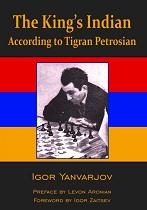
The King’s Indian According to Tigran Petrosian
by Igor Yanvarjov
2019
Russell Enterprises,Inc
Price €34,95
424 pages
ISBN:978-1-941270-57-8
Tigran Petrosian, the ninth world chess champion had a unique playing style that opponents found very hard to handle, often it wasn’t even clear what they were fighting against, as Petrosian’s deeply prophylactic play would be preventing ideas that had not even occurred to them.
Seldom I have seen such a impressive written book as this work from Igor Yanvarjov on his great chess hero Tigran Petrosian.
This work holds mainly hundreds of well analysed King’s Indian games, nearly 300 of them but for the good order there are also some other included games as the following lost from the legandary Bobby Fischer: Fischer,Robert James - Petrosian,Tigran V [B11]
Candidates Tournament Bled/Zagreb/Belgrade (2), 08.09.1959
1.e4 c6 2.Nc3 d5 3.Nf3 Bg4 4.h3 Bxf3 5.Qxf3 Nf6 6.d3 e6 7.g3 Bb4 8.Bd2 d4 9.Nb1 Bxd2+ 10.Nxd2 e5 11.Bg2 c5 12.0-0 Nc6 13.Qe2 g5 14.Nf3 h6 15.h4 Rg8 16.a3 Qe7 17.hxg5 hxg5 18.Qd2 Nd7 19.c3 0-0-0 20.cxd4 exd4 21.b4 Kb8 22.Rfc1 Nce5 23.Nxe5 Qxe5 24.Rc4 Rc8 25.Rac1 g4 26.Qb2 Rgd8 27.a4 Qe7 28.Rb1 Ne5 29.Rxc5 Rxc5 30.bxc5 Nxd3 31.Qd2 Nxc5 32.Qf4+ Qc7 33.Qxg4 Nxa4 34.e5 Nc5 35.Qf3 d3 36.Qe3 d2 37.Bf3 Na4 38.Qe4 Nc5 39.Qe2 a6 40.Kg2 Ka7 41.Qe3 Rd3 42.Qf4 Qd7 43.Qc4 b6 44.Rd1 a5 45.Qf4 Rd4 46.Qh6 b5 47.Qe3 Kb6 48.Qh6+ Ne6 49.Qe3 Ka6 50.Be2 a4 51.Qc3 Kb6 52.Qe3 Nc5 53.Bf3 b4 54.Qh6+ Ne6 55.Qh8 Qd8 56.Qh7 Qd7 57.Qh8 b3 58.Qb8+ Ka5 59.Qa8+ Kb5 60.Qb8+ Kc4 61.Qg8 Kc3 62.Bh5 Nd8 63.Bf3 a3 64.Qf8 Kb2 65.Qh8 Ne6 66.Qa8 a2 67.Qa5 Qa4 68.Rxd2+ Ka3 0-1,and is good in this book for nearly 3.5 pages of highly instructive text!
But first a view of the index: The Classical Variation
The Sämisch System,The Fianchetto Variation;The Benoni,Other Systems,Portrait of a Chess Player,Lessons from Petrosian,The Problem of the Exchange,Furman’s Bishop,Pawns are the soul of chess,Playing by Analogy,Manoeuvring Battle,experiments,Realist or Romantic? And at last the The King’s Indian with Colors – and Flanks – Reversed.
The first encounter that Tigran Petrosian had with Bobby Fischer was Petrosian,Tigran V - Fischer,Robert James [A16]
Interzonal Portoroz (13), 27.08.1958
1.c4 Nf6 2.Nc3 g6 3.g3 Bg7 4.Bg2 0-0 5.Nf3 d6 6.0-0 Nc6 7.d3 Nh5 8.d4 e5 9.d5 Ne7 10.e4 f5 11.exf5 gxf5 12.Nxe5 Nxg3 13.hxg3 Bxe5 14.f4 Bg7 15.Be3 Bd7 16.Bd4 Ng6 17.Re1 Rf7 18.Bf3 Qf8 19.Kf2 Re8 20.Rxe8 Qxe8 21.Bxg7 Rxg7 22.Qd4 b6 23.Rh1 a5 24.Nd1 Qf8 25.Ne3 Rf7 26.b3 Qg7 27.Qxg7+ Kxg7 28.a3 Rf8 29.Be2 Ne7 30.Bd3 h6 31.Rh5 Be8 32.Rh2 Bd7 33.Rh1 Rh8 34.Nc2 Kf6 35.Nd4 Kg7 36.Be2 Ng8 37.b4 Nf6 38.Bd3 axb4 39.axb4 Kg6 40.Ra1 Ng4+ 41.Ke2 Re8+ 42.Kd2 Nf6 43.Ra6 Rb8 44.Ra7 Rc8 45.c5 bxc5 46.bxc5 dxc5 47.Nf3 Kf7 48.Ne5+ Ke7 49.Nxd7 Nxd7 50.Bxf5 Rf8 51.g4 Kd6 52.Bxd7 Kxd7 53.Ke3 Re8+ 54.Kf3 Kd6 55.Ra6+ Kxd5 56.Rxh6 c4 57.Rh1 c3 58.g5 c5 59.Rd1+ Kc4 60.g6 c2 61.Rc1 Kd3 62.f5 Rg8 63.Kf4 Kd2 64.Rxc2+ Kxc2 65.Kg5 c4 66.f6 c3 67.f7 ½-½,
Our author writes:The first official meeting of two outstanding chess players not only had great competitive significance but also very important for both in the psychological sense.
This I believe, explains some of the errors and inaccuracies made by rivals.
We present this interesting game with Robert Fischer’s annotations from his excellent book My 60 Memoriable Games.The preface to this game belongs to his friend and co-author,grandmaster Larry Evans.
So,what is the main secret of Petrosian’s success in the King’s Indian? At first,perhaps,it was a lucky combitation of his way of thinking and his chess education {Nimzowitsch} that favourably complimented the fabric of his complicated opening.But then,as Petrosian perfected his play,these ties grew stronger and deeper
Included is a foreword by Igor Zaitsev and a preface by Levon Aronian.
Conclusion: One of those outstanding chess books!

Emanuel Lasker: A Reader by Taylor Kingston
2019
Russell Enterprises,Inc
Price €34,95
400 pages
ISBN: 978-1-949859-01-0
Emanuel Lasker was born on 24 December, 1868 in Berlinchen today known as Barlinek in Polen,was a German chess player, mathematician, and philosopher and who was World Chess Champion for 27 years.
As we can see in this fantastic compiled wide ranging sampling of Lasker,that he did not devote himself totally to chess,and there were periods in his career where he did not touch a chess piece for years.
But he stayed the longest reign of any officially recognised World Chess Champion in history and that makes this work more than interesting.
First a view of the index: Lasker’s magazine London Chess Fortnightly (1892-93)
The Hastings 1895 tournament book, Common Sense in Chess (1896),
Lasker’s Chess Magazine (1904-1909), A memorial tribute to Pillsbury, from The Chess Player’s Scrapbook (1906), Full coverage of the 1907 Lasker-Marshall and 1908 Lasker-Tarrasch World Championship matches,The St. Petersburg 1909 tournament book
Lasker’s and Capablanca’s books on their 1921 title match, The discussion of the theory of Steinitz from Lasker’s Manual of Chess,An examination of Lasker’s endgame instruction and studies by GM Karsten Müller,Summaries of and extensive excerpts from two of Lasker’s philosophical works, Struggle(1907) and Die Philosophie des Unvollendbar (The Philosophy of the Unattainable,1919), and his forgotten sociological rarity, The Community of the Future (1940)A discussion of Lasker’s mathematical works by Dr. Ingo Althöfer of Jena University
A look at Lasca, a checkers-like game invented by Lasker.
I enjoyed the words from Lasker on the 1921 Lasker – Capablanca World Championship Match,I therefore quit thinking about the match and devoted myself to other affairs…Then came a year’s end a telegram from Senior Truffin,saying that if I still wished to play the match,a telegraphic transfer of $3,000 was ready.The weather in Havanna would be good until the end of April.
I considered the offer.The $3000 should cover travel costs,both going and returning.
By the start of the natch I was to receive another $4,000 for living exspensives,and at the end of the match the remaining $4,000..Of course,there was the sub-tropical climate…but I would play only in the cool of the evening.And my training-between then and march 10 was 2,5 nonths,which I thought would do.
In the fifth match game,Lasker made a terrible blunder with 45…Kf8??
Please see: Capablanca,Jose Raul - Lasker,Emanuel [D63]
World-ch11 Capablanca-Lasker +4-0=10 Havana (5), 29.03.1921
1.d4 d5 2.Nf3 Nf6 3.c4 e6 4.Bg5 Nbd7 5.e3 Be7 6.Nc3 0-0 7.Rc1 b6 8.cxd5 exd5 9.Qa4 c5 10.Qc6 Rb8 11.Nxd5 Bb7 12.Nxe7+ Qxe7 13.Qa4 Rbc8 14.Qa3 Qe6 15.Bxf6 Qxf6 16.Ba6 Bxf3 17.Bxc8 Rxc8 18.gxf3 Qxf3 19.Rg1 Re8 20.Qd3 g6 21.Kf1 Re4 22.Qd1 Qh3+ 23.Rg2 Nf6 24.Kg1 cxd4 25.Rc4 dxe3 26.Rxe4 Nxe4 27.Qd8+ Kg7 28.Qd4+ Nf6 29.fxe3 Qe6 30.Rf2 g5 31.h4 gxh4 32.Qxh4 Ng4 33.Qg5+ Kf8 34.Rf5 h5 35.Qd8+ Kg7 36.Qg5+ Kf8 37.Qd8+ Kg7 38.Qg5+ Kf8 39.b3 Qd6 40.Qf4 Qd1+ 41.Qf1 Qd7 42.Rxh5 Nxe3 43.Qf3 Qd4 44.Qa8+ Ke7 45.Qb7+ Kf8 46.Qb8+ 1-0.
Included is a foreword by Andy Soltis.
Conclusion: A must read for all lovers of historical chess.
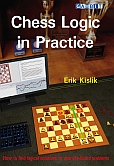
Chess Logicin practice by Erik Kislik
2019
Gambit Publications Ltd
http://www.gambitbooks.com
E-mail info@gambitbooks.com
238 pages
Price $26.95
ISBN (13 digits):978-1-911465-30-0
Erik Kislik is an International Master and computer chess expert from California who lives in Budapest, provides the reader with a well thought and originally made strategy book, based in big lines on two important major sections: Thinking Concepts and Positional Concepts, and of course all under divided in to many other highly instructive chapers as: Painfully Slow Moves, Focal Points, Reciprocal Logic Fighting against Centralized Pieces,When Playing a Bad Move Wins a Good Game,A Chronically Weak King and more!
The modern chess student of today even learns from computer chess as I found in this book,as from instructive model games,as from AplhaZero and Stockfish.
Many experienced tournament players play there best chess due to their tenacity when there backs against the wall.
Kislik explains:When you have to find only moves to stay in the game, you tend to rise the occasion. It may sound surprising, but a lot of grandmasters have told me that their best wins have come from terrible positions.
A fine example of tenacity in action comes from the author himself:
Vokac,Marek (2471) - Kislik,Erik Andrew (2327) [A16]
Prague op-A 10th Prague (6), 11.01.2011
1.c4 Nf6 2.Nc3 d5 3.cxd5 Nxd5 4.Nf3 g6 5.h4 Nxc3 6.bxc3 h6 7.d4 Bg7 8.Bf4 c5 9.Qd2 cxd4 10.cxd4 Nc6 11.e3 0-0 12.Rc1 Bg4 13.Bb5 Bxf3 14.gxf3 Rc8 15.Bxc6 Rxc6 16.Rxc6 bxc6 17.Ke2 Qd5 18.Rc1 Rd8 19.Qc2 e5 20.dxe5 Bxe5 21.Bxe5 Qxe5 22.Qxc6 Qb2+ 23.Qc2 Qb5+ 24.Qc4 Qb2+ 25.Rc2 Qb1 26.Rd2 Rxd2+ 27.Kxd2 Qb2+ 28.Ke1 Qb7 29.Ke2 Kg7 30.a4 a6 31.Qd4+ Kg8 32.Qf6 h5 33.Kf1 Qc8 34.Kg2 Qc4 35.Qd8+ Kh7 36.a5 Qb5 37.Qb6 Qc4 38.Qf6 Kg8 39.e4 Qc8 40.Qd6 Kg7 41.Qd3 Qe6 42.Qc3+ Kh7 43.Qc7 Kg7 44.Kg3 Kh7 45.Qb6 Qc4 46.Qb7 Kg7 47.Qd5 Qf1 48.Qd4+ Kg8 49.Kh2 Kh7 50.Qd2 Kg7 51.f4 Qc4 52.f3 Qf1 53.Qc3+ Kh7 54.Qe3 Qb5 55.Qe1 Kg8 56.Kg3 Kh7 57.Qa1 Kg8 58.Qa2 Qf1 59.Qf2 Qa1 60.Qc5 Qe1+ ½-½ Kislik honestly explains the first step was just to survive the first 15 moves.
Also interesting are the words from Kislik after this game:Most of the Ims in my generation are very good at finding only moves or the only defensive tries.When you have analysed so many games and ideas with an engine, that is expected. A bigger issue for most players is logical formulation of the game, strategic chess and positional understanding.
Included are some interesting exercises covering unusual pawn structures and strange material imbalances.The goal is to understand what is going on.
Conclusion: One of those super instructive reads!
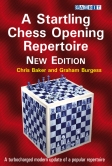
A Starling chess opening repertoire – New Edition by Chris Baker and Graham Burgess
2019
Gambit Publications Ltd
http://www.gambitbooks.com
E-mail info@gambitbooks.com
190 pages
Price $22.95
ISBN (13 digits):978-1-911465-32-4
It is a great pleasure for me to enounce this high tech expanded update of Chris Baker 1998,Cadogan repertoire book A Startling Chess Opening Repertoire.
The cooperation of Graham Burgess,who holds the world record for marathon blitz, has only made this work better, but the spirit and aims of the original edition, have not been lost.
With high tech I mean the use of the new generation of neural-network based engines inspired by AlphaZero, and that gives a blow to many repertoire lines mentioned in this so creative written work.
To cover as repertoire line the Cochrane Gambit 1.e4 e5 2.Nf3 Nf6 3.Nxe5 d6 4.Nxf7! is more than impressive, for a moment my thoughts went back to Sakaev and his book the Petroff: an Expert Repertoire for Black where he wrote:The Cochrane Gambit was invented as long as the 19th century.
There where times when such attempts to provoke an early crisis on the board were terrifying to black.
Nowadays in the computer age, professional chess players only smile condescendingly at such romantic experiments.
The problem with Sakaev is that he mentions as best line 1.e4 e5 2.Nf3 Nf6 3.Nxe5 d6 4.Nxf7 Kxf7 5.d4 c5! But forgot to look at 6.Nc3!
This move has been successfully used by GM Pridorozhny and is probably white's best try against 5....c5.
As we can see in the following example: Pridorozhni,Aleksei (2589) - Khanin,Semen (2485) [C42] Voronezh op-A 22nd Voronezh (5), 16.06.2018
1.e4 e5 2.Nf3 Nf6 3.Nxe5 d6 4.Nxf7 Kxf7 5.d4 c5 6.Nc3 Nc6 7.Bc4+ d5 8.Nxd5 Be6 9.Bg5 cxd4 10.0-0 Be7 11.Nxe7 Qxe7 12.Bd3 h6 13.Bh4 g5 14.Bg3 h5 15.f4 h4 16.Be1 Bg4 17.Qd2 gxf4 18.h3 Rag8 19.hxg4 Rxg4 20.Rxf4 Qd6 21.Rf5 Ne5 22.Qb4 Qe6 23.Qb3 Qxb3 24.axb3 Ke6 25.Ra5 Nc6 26.Bc4+ Ke7 27.e5 Nd7 28.Rb5 h3 29.g3 h2+ 30.Kh1 Re4 31.Bd2 Ncxe5 32.Bb4+ Ke8 33.Rxb7 a5 34.Bxa5 Nxc4 35.bxc4 Re2 36.Ra7 Rh3 37.Bb4 Rxc2 38.Ra8+ Nb8 39.Rxb8+ Kd7 40.Rf7+ Ke6 41.Re7+ Kf5 42.Rf8+ Kg6 43.Re1 Rxb2 44.Bc5 Rd2 45.Rd8 d3 46.Bb4 Rc2 47.Rxd3 Rxc4 48.Bd2 Kf5 49.Kg2 Kg4 50.Rh1 Re4 51.Be1 Rh7 52.Bf2 Re2 53.Rd4+ Kg5 54.Rf4 1-0.
Covered is also the classic Max Lange Attack and so much more! I love this book!
Conclusion:This is a must have repertoire book!
Chess DVD's
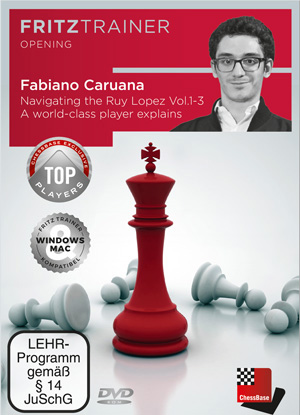

Navigating the Ruy Lopez Vol.1-3
by Fabiano Caruana
2019
http://www.chessbase.com
E-Mail info@chessbase.com
Price Euro 79.90
Windows 7 or higher
Minimum: Dual Core, 2 GB RAM, DirectX11, graphics card with 256 MB RAM, DVD-ROM drive, Windows Media Player 9, ChessBase 14/Fritz 16 or included Reader and internet access for program activation. Recommended: PC Intel i5 (Quadcore), 4 GB RAM, Windows 10, DirectX11, graphics card with 512 MB RAM or more, 100% DirectX10-compatible sound card, Windows Media Player 11, DVD-ROM drive and internet access for program activation.
MacOSX
only available as download! Minimum: MacOS "Yosemite" 10.10
The phenomenal Fabiano Caruana provides the user with this heavy loaded three part in one coverage,where the user will find a complete repertoire for
white, with an impressive over 16 hours video entertainment.
Of course you can go for one DVD but then you pay much more and to be honest all sections do belong one way or the other together.
Specially wit part one, because section two and three need the first DVD for a correct installation.
But first a view of the index so the user can see if the mentioned repertoire lines lay in your interest: The Classical Main Lines (Chigorin 9…Na5, Zaitsev 9…Bb7 and Breyer 9…Nb8), Anti-Classical (8.a4), Anti-Marshall (8.a4), Modern Arkhangelsk (6…Bc5), Open Ruy Lopez (5…Nxe4), Berlin Defence (3…Nf6 and 4.Nxe4), Averbakh Variation (6…d6), Schliemann Variation (3…f5), Smyslov Defence (3… g6), Cozio Defence (3…Nge7 and 3…a6 4.Ba4 Nge7), Bird’s Defence (3…Nd4), Steinitz Defence (3…d6) and Modern Steinitz (4…d6), Classical Defence (3…Bc5), Norwegian Defence (4…b5 5.Bb3 Na5).
Included is a Database with Caruana’s games in the Ruy Lopez,and that are 386 games plus uncountable hold heavy loaded analyses.
The files complete analysis from Caruana belongs to the best I every had on my computer!
Bonus: Training with ChessBase apps - Memorize the opening repertoire and play key positions against Fritz on various levels.A fine example with the Berlin Wall is: Caruana,Fabiano (2783) - Carlsen,Magnus (2881) [C67]
Gashimov Memorial-A 1st Shamkir (4), 23.04.2014
[Caruana,F]
1.e4 e5 2.Pf3 Pc6 3.Lb5 Pf6 4.0-0 Pxe4 5.d4 Pd6 6.Lxc6 dxc6 7.dxe5 Pf5 8.Dxd8+ Kxd8 9.h3 h6 [9...Ld7 10.Td1 Le7 11.Pc3 Kc8 12.Lg5 h6 13.Lxe7 Pxe7 14.Td2 c5 15.Tad1 Le6 16.Pe1 Pg6 17.Pd3 b6 18.Pe2 Lxa2! Anand-Carlsen, Chennai 2013;] 10.Td1+ Ke8 11.Pc3 Ld7 12.Lf4 Td8 13.Pe4 [13.e6 Lxe6 14.Lxc7 Txd1+ 15.Txd1 Le7 16.g4 Ph4 17.Pd4 Ld7 18.Te1 Kf8 19.Lg3 g5 20.Lxh4 gxh4 21.Pe4 Kg7 ] 13...Le7 [13...c5!? 14.e6 Lxe6 15.Lxc7 Tc8 16.Lh2 ] 14.g4 Ph4 15.Pxh4 Lxh4 16.Kg2 Le6 17.f3 b6 18.b3 c5?! [18...Td7 19.c4 Kd8 20.Lg3 Le7 21.f4 g6 22.Tf1! ] 19.c4 [19.Lg3 Le7 20.c4 ] 19...Td7 [19...Td4 20.Le3 Txd1 21.Txd1 ] 20.Lg3 Le7 21.Txd7 Lxd7 [21...Kxd7 22.f4 g6 23.Tf1 Kc8 24.f5 gxf5 25.gxf5 Ld7 ] 22.Pc3 Kd8?! [22...Ld8 23.Pd5 Lc8 ] 23.Pd5 Te8 [23...c6 24.Pxe7 Kxe7 25.f4 ] 24.Td1 Kc8?? [24...c6 25.Pxe7 (25.Pc7 Tg8 26.e6 fxe6 27.Pxe6+ Kc8) 25...Txe7 26.Lh4 g5 27.Lg3 ] 25.Pxc7 Td8 26.Pd5 Te8 27.Le1 Ld8 28.Lc3 g6 29.Kg3 [29.a4! ] 29...b5 30.cxb5 Lxb5 31.Pe3 Te6 32.f4 Ta6 33.Td2 h5 34.gxh5 gxh5 35.Pf5 Tg6+ 36.Kh2 Lc6 37.Pd6+ Kb8 38.f5 Tg8 39.f6! Lb6 40.Pc4? [40.Pxf7! c4 41.h4! ] 40...Te8? [40...Lc7 41.La5 ] 41.Pd6 Tg8 42.Pxf7! c4 43.h4 Tg4 44.e6 Le3 45.Le5+ Ka8 46.Td8+ Kb7 47.Lg3 c3 48.Tb8+ Ka6 49.Tc8 Ld5 [49...Tc4 50.bxc4 c2 51.Txc6+ Ka5 52.Lc7+ Ka4 53.Ta6+ Kb4 54.Ld6+ Kc3 55.La3 ] 50.Txc3 Ld4 51.Td3 Te4 52.Td2 Txe6 53.Pg5 1-0.
Latest material that I found come from August 2019 and that makes it all very up to date!
Conclusion: Caruana’s files belong to the best that money can buy!
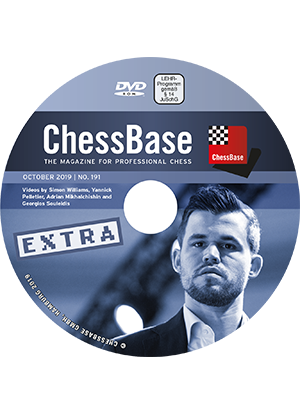
ChessBase Magazine extra issue 191
October 2019
Videos by Adrian Mikhalchishin,Yannick Pelletier and Georgios Souleidis and Simon Williams
ChessBase
http://www.chessbase.com
E-Mail info@chessbase.com
ISSN 1432-8992
Euro 12.99
System requirements:
Minimum: Pentium III 1 GHz, 1 GB RAM, Windows Vista, XP (Service Pack 3), DirectX9 graphic card with 256 MB RAM, DVD-ROM drive, Windows Media Player 9, ChessBase 12/Fritz 13 or included Reader and internet connection for program activation. Recommended: PC Intel Core i7, 2.8 GHz, 4 GB RAM, Windows 8.1 or Windows 10, DirectX10 graphic card (or compatible) with 512 MB RAM or better, 100% DirectX10 compatible sound card, Windows Media Player 11, DVD-ROM drive and internet connection for program activation.
Besides the two smashing chess files from 44274 entries and the 27 extra heavy loaded lucky bag files ,there are also some higly instructive video files on this DVD,and well from the well known Simon Williams on the Slav Geller Gambit,Yannick Pelletier presents a exciting Semi - Slav,and the great Adrian Mikhalchishin digs in a interesting idea in the Nimzo Indain with 4.Qc2 and 5.e5.
The lucky bag annotations truly belong to the best as we can see in the following impressive example:
Gelfand,Boris (2676) - Smirin,Ilia (2594) [E97]
Netanya Masters Netanya (6), 28.06.2019
[Stohl,Igor]
After starting with 5 draws, Boris Gelfand moved to the top of the tournament table by scoring two wins against his former favourite - the King's Indian. 1.d4 Nf6 2.Nf3 g6 3.c4 Bg7 4.Nc3 d6 5.e4 0-0 6.Be2 e5 7.0-0 Nc6 [In the last round Gelfand faced 7...Na6 and now: After 8.Be3 we are at a branching point: (The other main move is 8.Re1 c6 when the immediate blockade 9.d5!? (9.Bf1 is the most usual move.; Personally I prefer 9.Rb1!? ) deserves attention: 9...Nc5 10.Qc2 Qb6 11.h3 cxd5 12.cxd5 Bd7 13.Be3 Rfc8 14.Rac1 (14.Nd2!? Qc7 15.a4 Ne8 16.Bb5± f5? 17.Bxc5 dxc5 18.Nc4 f4 19.d6! Qd8 20.Qd3 Kh8 21.Rad1 Rc6 22.Bxc6 bxc6 23.Nb1 Bf6 24.Nbd2 Ng7 25.Nf3 Qe8 26.Qa3 1-0, Ftacnik,L (2560)-Damljanovic,B (2567) Tekirdag 2016) 14...Qd8 15.Qb1 a5 16.Nd2 Nh5 17.Nc4 Bf8 18.Bg4?! (18.Bxh5 gxh5 19.a4f î? 19...Nb3 20.Nb6) 18...Bxg4 19.hxg4 Nf4 20.Bxf4 exf4 21.e5 dxe5 22.Nxe5 Bg7 23.Nf3 Bxc3 24.Rxc3 Qxd5 25.Re5 Qd6 26.Qc1 b6 27.Qxf4 Ne6= Karjakin,S (2752)-Carlsen,M (2861) Cupar rpd 2019) 8...c6 (8...Ng4 9.Bg5 Qe8 and now 10.Re1 still remains topical: 10...exd4 11.Nxd4 (11.Nd5 d3 12.Bxd3 f6 (12...c6 13.Ne7+ Kh8 14.Nxc8 Rxc8 15.Bf1 (15.h3 Ne5 16.Bf1 Nc5 17.Nd4 Ned3 18.Bxd3 Bxd4 19.Bh6 Bg7 20.Bxg7+ Kxg7 21.b4 Ne6 22.Be2 Rd8 23.Bg4 c5 24.Bxe6 Qxe6 25.Qb3 cxb4 26.Qxb4 Rd7 27.Rad1 Rc8= Svane,R (2570)-Adhiban,B (2682) Moscow 2017) 15...Nc5 (¹15...Bxb2 16.e5!?N dxe5 17.h3 Bxa1 18.hxg4 f6 19.Bd2 Bb2 20.Qb3 Bd4 21.Nxd4 Qd7 22.Nf3 e4 23.Rxe4 Nc5 24.Qe3 Nxe4 25.Qxe4©) 16.Qxd6 Nxe4 17.Qa3 f5 18.h3 Ne5 19.Bf4± Kramnik,V (2799)-Topalov,V (2780) Nice rpd 2008) 13.Bf4 Ne5 14.Bxe5 dxe5 15.c5 c6!? (15...Rf7 16.Bxa6 bxa6 17.c6 Be6 Bacrot,E (2704)-Fressinet,L (2712) Calvi rpd 2015 18.Qa4!?²) 16.Bxa6 cxd5 17.Qxd5+ Be6 18.Qxb7 Rb8 19.Qc7 Rxb2 20.Reb1 Rxb1+ 21.Rxb1 Rf7 22.Qa5 Qc6² Ingersol,H (2408)-Le Page,C (2425) email 2013 Although Black managed to hold a draw a pawn down, the whole line does seem rather suspect...) 11...Qe5 12.Nf3 Qc5 13.Bh4 Be6 Here the recent treatment is 14.Rc1!? a) 14.Nd5 c6 15.Ng5 cxd5 16.cxd5 Bxd5 17.Qxd5 (17.Rc1 Bc4!? 18.Rxc4 Nxf2=) 17...Qxd5 18.exd5 Nf6 19.Bg3 Nb4 20.Rac1 Nfxd5 21.Bxd6 Rfc8 22.Bxb4 Nxb4 23.Bc4 Bxb2 24.Bxf7+= ½, Muschalek,I (2413)-Mego,P (2347) email 2007; b) 14.Nd2 Bxc3!? (14...Ne5 15.Nd5²) 15.bxc3 Ne5÷ ½, Korotylev,A (2616)-Kokarev,D (2551) Krasnoyarsk 2007; 14...Bxc4 15.Nd5 Bxe2 16.Qxe2 Qa5 17.h3 (17.Nd2!?) 17...Ne5 18.Nf6+ (More dangerous is ¹18.Nxe5! Bxe5 19.f4f) 18...Kh8?! (¹18...Bxf6! 19.Bxf6 Nd7÷) 19.Nxe5 dxe5 20.a3© Here Black's pieces lack coordination and he is under strong pressure: 20...Rad8 21.Nd5 Rxd5 (21...Rd7 22.b4! Qa4 23.Qb2±) 22.exd5 Qxd5 23.Red1± /+-, Lysyj,I (2635)-Mirzoev,E (2511) Skopje 2019) 9.dxe5!? (White is not in a mood for the more principled 9.d5 Ng4 10.Bg5 f6 11.Bh4 c5 12.Ne1 Nh6÷ with complex play.) 9...dxe5 10.Qxd8 Rxd8 11.h3 is not as simple, as it seems: Black should tread with care:
(Also after 11.Rfd1 Black usually reacts with 11...Re8!) The alternative with the best reputation is 11...Re8!? (11...Nc7 12.Rfd1 Re8 13.b4! Nh5 14.Rac1 Nf4 15.Bf1 Nfe6 16.c5 f6 17.Nd2 a5 18.a3 f5 19.exf5 gxf5 20.Nc4f axb4 21.axb4 f4 22.Bd2 Nd4 23.Nd6 Rf8 24.Nxc8 Raxc8 25.Bc4+ Kh8 26.Ne4 Ncb5 27.Kf1 Rcd8 28.Ra1 h6 29.Rdc1 Kh7 30.Bc3 (30.Ra2!?±) 30...Nxc3 31.Rxc3 Rd7 32.Bd3 Kh8 33.Rca3 Rfd8? (33...Ne6² /î?S and the fight goes on.) 34.Ra8 Nb3 35.Rxd8+ Rxd8 36.Nd6!+- Gelfand,B (2676)-McShane,L (2688) Netanya 2019) 12.a3 b6 13.b4 Bb7 14.Nd2 Bf8 15.Nb3 (15.Rfd1 Kg7 16.Nb3 c5 17.bxc5?! Nxc5 18.Nxc5 Bxc5 19.Bxc5 bxc5= Moradiabadi,E (2576)-Shimanov,A (2642) Burlingame 2017 Black is fine, although White's î?¨ lands on d5, the î?§e2 remains passive.) 15...c5 16.b5 Nc7 17.Nd2 Ne6 (17...Red8!? î?18.Nd5 Nfxd5 19.cxd5 Ne8) 18.Nd5 Bg7 19.a4 Nf4 20.Rfe1 Nxe2+ 21.Rxe2 Bxd5 22.cxd5 a5 23.bxa6 Rxa6 24.Ree1 Rea8 25.Reb1 Nd7 26.Nc4 f5" Beliavsky,A (2646)-Markus,R (2603) Rogaska Slatina 2009] 8.d5 Ne7 9.Bg5!? Boris and Ilia are contemporaries, both originate from Belarus and both have extensive experience with the King's Indian - in Gelfand's case from both sides of the board. The text-move is a sideline, but quite venomous, Boris has tried it only once almost 30 years ago. [He usually preferred the far more popular continuations 9.Nd2 ;
9.Ne1;
or 9.b4 The latter he used also in earlier direct encounters with Smirin.] 9...Nh5 Black has already played this in the past, we'll check the alternatives: [<9...Nd7 10.Nd2 f5 ¹11.f3! (11.exf5 gxf5 12.f4 Nf6 13.Bh5?! (13.fxe5 dxe5 14.c5÷) 13...e4 14.Nb3 c5! 15.dxc6?! bxc6 16.Kh1 d5 17.Be2 Kh8 18.Bh4 Ng6 19.Bf2 Nxf4 20.Bc5 Nxe2 21.Bxf8 Ng3+ 22.hxg3 Qxf8 23.cxd5 cxd5 24.Nxd5 Ng4f Gelfand,B (2590)-Grivas,E (2445) Haifa 1989 Black has a dangeous initiative, already White's best chance is 25.Qxg4 fxg4 26.Rxf8+ Bxf8³ with an unpleasant endgame.) 11...f4 12.Bh4 Bf6 13.Bf2 g5 14.b4 Ng6 15.c5 Be7 16.c6 Nf6 17.cxb7 Bxb7 18.Nc4 Rf7 19.Na5 Bc8 20.Nc6 Qf8 Atalik,S (2538)-Gajwa,A (2284) New Delhi 2018
21.Nxa7 Bd7 22.Bb5!± and Black's compensation is hardly sufficient.;
However, the main question probably is is White's dark-squared î?§ is worth one or two tempi after 9...h6 10.Bxf6 (White has also played 10.Bd2 or; 10.Be3 , but I don't see any deeper sense in forcing Black to play h6.) 10...Bxf6 11.b4 and now: Black should strive to combine queenside and central counterplay with 11...a5 (11...Bg7 12.c5 f5 13.Nd2 fxe4 (13...Kh8 14.Nc4 Ng8 seems too complicated and slow: 15.a4 Nf6 16.f3 h5 17.a5 Bh6 18.Qe1 Qe7 19.Kh1 Kg7 20.Bd3 h4 21.exf5 gxf5 22.cxd6 cxd6 23.f4 e4 24.Be2 Ne8 25.Ne3± Gausel,E (2555)-Hillarp Persson,T (2410) Reykjavik 1998 White has the usual queenside space advantage, moreover here he soon managed to effctively open the kingiside with a timely g4.) 14.Ndxe4 Nf5 15.Bg4 a5 16.cxd6 (16.b5 b6 17.c6 h5 18.Bh3 Qh4 19.Re1 Bh6 20.Ng3 Berkes,F (2653)-Mihok,O (2543) Hungary 2018 After 20...Bf4" Black would have no real reason to complain.; Maybe White should prefer the simple 16.a3 ) 16...cxd6?! (¹16...axb4!?") 17.bxa5 Rxa5 18.a4 h5 19.Bh3f is pleasant for White and his advantage increased substantially after 19...Nd4? 20.Bxc8 Qxc8 21.Rb1 Ra6 22.Qd3 h4 23.h3 Qd7 24.Rb4± Gonzalez Zamora,J (2515)-Minero Pineda,S (2415) San Salvador 2001) 12.a3 ¹c6!? (12...Bg7 13.c5 f5 14.Bd3 (14.Nd2!?) 14...Kh8 15.Rc1 axb4 16.axb4 Bd7 (16...c6!") 17.Nd2 f4?! 18.Nb5 Rf6 19.Qb3 g5 20.cxd6 cxd6 21.Nc7 Rc8 22.Ne6 Bxe6 23.dxe6 g4 24.Bb5 Rxc1 25.Rxc1f Erdos,V (2614)-Mamedov,R (2689) Minsk 2017) 13.Rc1 (13.Nd2 Bg5! 14.Nb3 cxd5 15.cxd5 axb4 16.axb4 Bd7 17.Na5 Qc7 18.Qd3 Rfc8 19.Nb5 Qb6= /î?®, Pelletier,Y (2547)-Perske,T (2456) Radenci 2019) 13...Bg7 14.Qb3 (14.c5 axb4 15.axb4 Bg4=) 14...cxd5 (¹14...axb4!? î?15.Qxb4 c5) 15.exd5 (After the more natural 15.cxd5 the swap 15...axb4 16.Qxb4! already favours White) 15...b6 16.Rfd1 axb4 17.axb4 Bd7 18.b5 (18.Ra1÷ Pelletier) 18...f5 (¹18...g5! and Black's play develops faster, than n the game.) 19.Na2 g5 20.Nb4 Ng6 21.Nc6 Qf6?! (21...Qc7!?) Pelletier,Y (2587)-Bologan,V (2627) Cap d'Agde rpd 2002 22.c5! dxc5 23.Nd2±] 10.Re1 So far this hasn't been played much and is most probably the result of home preparation. [10.g3 f6 (10...h6!? 11.Bd2 Bh3 12.Re1 f5 13.Nh4 Nf6 14.exf5 gxf5" Kotronias) 11.Bd2 f5 12.exf5 Nxf5 13.Ne4 Nf6 14.Bd3 Bd7 15.Qb3 Rb8 16.a4 b6 17.Qc2 a5 18.Kg2 h6 19.Nxf6+ Qxf6 20.Be4 g5 21.h3 Rf7 22.Qd3 Rbf8 23.b3 Qd8 24.Rae1 Rf6 25.Nh2 Qc8 26.f3 R6f7 27.Rh1 Qd8 28.Bc3 h5 29.Nf1 Qf6 30.Ne3 h4 31.Nxf5 Bxf5= Eingorn,V (2560)-Smirin,I (2530) Odessa 1989 Although White controls e4, he has no obvious way to improve his position.;
10.Bd3 h6 11.Bd2 Nf4 12.Bc2 g5 13.Ne2 f5 14.Ng3 fxe4 15.Bxe4 leads to a position of a similar type, as in Eingorn-Smirin above. However, the risky follow-up 15...g4?! (15...c6!?) 16.Nh4 Nexd5 17.Nhf5! Nf6 18.Bc2 Be6 19.Re1 (A human choice, Stockfish suggests 19.f3!? Bxc4 20.Rf2© î?") 19...Qd7 20.c5© î?', Berkes,F (2678)-Smirin,I (2594) Batumi ol 2018;
Finally the most played move is 10.Ne1 , but after 10...Nf4 11.Nd3 Nxe2+ 12.Qxe2 h6 Black gets typical KID counterplay: 13.Bd2 f5 (13...g5!?) 14.f4 exf4 15.Nxf4 g5 16.Nh5 Bd4+ 17.Kh1 f4 18.g3 Bh3 19.gxf4 Bxf1 20.Rxf1 Ng6 21.e5 (21.Qd3 Bxc3 22.Bxc3 Nxf4 23.Qd4 Qe7 24.Qh8+ Kf7 25.Qh7+ Ke8 26.Bg7 Rd8 27.Nxf4 Rxf4 28.Rxf4 gxf4 29.Qg6+ Qf7 30.Qxh6 f3 31.Qh8+ Kd7 32.Qh3+ Ke7 33.Qh4+= Kotronias) 21...gxf4 22.Qd3 Qg5 23.Nf6+ Rxf6 24.exf6 Qxf6 25.Ne2 Be5 26.Rg1 Kh7 27.Nxf4 Bxf4 28.Bxf4 b6 29.Bd2 Rf8 30.Re1 Rf7= Grube,A (2141)-Draeger,W (2108) email 2013] 10...h6 [10...Nf4?! 11.Bxf4 exf4 12.Qd2² and Black must either sacrifice a î?©, or play the disharmonious 12...Bh6] 11.Bd2 f5 Smirin strives for a similar position as in his aforementioned game against Eingorn. [11...Nf4 12.Bf1 g5 13.h3 f5 14.exf5 Bxf5?! (¹14...Nxf5!? 15.Ne4 leads to a position we will see below.) 15.Bxf4! exf4?! (15...gxf4 is more circumspect, but White is still better after 16.Bd3²) 16.Bd3 Qd7 17.Nb5 Ng6 18.Re6! Bxe6 19.dxe6 Qxe6 20.Nxc7 Qd7 21.Nxa8 Ne5 22.Nxe5 Bxe5 23.Qh5 Rxa8 24.Qxh6± î?"î?,, Xu,Y (2533)-Karthikeyan,M (2604) Bhubaneswar 2018] 12.Nh4!?N [Gelfand wants more than the standard position after 12.exf5 Nxf5 13.Ne4 Nf4 14.Bf1 g5 15.h3÷ /î?¯ This is also slightly better for White and he gradually outplayed his opponent after 15...b6 (15...Nd4!?) 16.g3 Ng6 17.Bc3 a5 18.b3 Bd7 19.Bg2 Qe7 20.a3 Qf7 21.b4 axb4 22.axb4 Rxa1 23.Bxa1 b5 24.c5 Nge7 25.g4 Nh4 26.Nxh4 gxh4 27.cxd6 cxd6 28.Qc2 Nxd5 29.Nxd6 Qe6 Xu,Y (2526)-Calistri,T (2302) Bastia blitz 2017 30.Nf5+-] 12...Nf4?! [12...Nf6 13.exf5 gxf5 14.g3² is also pleasant for White, but the resulting position is more complex, than the one from our game.] 13.Bxf4 exf4 14.exf5 g5 [14...Bxf5 15.Bg4 (or 15.Bd3f also gives White the initiative.) ] 15.Ng6 Rxf5 [Natural, after 15...Nxg6 16.fxg6 Bf5 17.Bd3± Black won't regain the pawn so easily.] 16.Bh5! Maybe Smirin underestimated this sortie, White's î?§g6 will be a real nuisance. 16...Nxg6 17.Bxg6 Rf8?! This passive retreat puts Black on the verge of losing, as White tightens his grip on the position. [¹17...Re5!? 18.Qh5 (18.Rxe5 Bxe5 19.Qh5 Kg7 20.Bd3 Qf6 21.Nb5 Qf7 22.Qxf7+ Kxf7 23.Nxc7 Rb8") 18...Qe7 ¹19.Kf1! (After 19.Rxe5 Qxe5 20.Kf1 Bf5!? (20...Bd7 21.Re1 - 19.î?¤f1!) 21.Re1 Qf6 (21...Bxg6 22.Qxg6 Qf6²) 22.Bxf5 Qxf5² White's advantage is less distinct.) 19...Bd7 (19...g4 20.Rxe5 î? 20...Qxe5? 21.Re1! Qxh5 22.Re8+ Bf8 23.Bxh5+-) 20.Rxe5 Qxe5 21.Re1 Qf6 22.Ne4! Qxb2 23.Bf7+ Kh8 (23...Kf8 24.Qg6+- î?î?§e6) 24.Nxg5 Bf5± /î?¯ Although White's attack is dangerous, there is no forced win in sight and Black's pieces are quite active.] 18.Qh5! g4 [18...Qf6 runs into 19.Nb5 , so Black prepares î?¥g5...] 19.Ne4 And Gelfand promptly prevents it! 19...Bd7 Black is under heavy pressure, but [19...a5!?± could have at least spared a tempo. 20.h3 gxh3 21.gxh3 Qe7] 20.c5! Bc8 [20...dxc5 21.Nxc5 and î?¨e6 will decide sooner or later.] 21.Rad1 a5 22.h3! White's forces are ideally coordinated, to develop his attack he should open the position. 22...gxh3 Practically suicide, the î?¤g8 can't survive on the open g-file. [22...g3 would perhaps offer longer resistance, but after 23.fxg3 fxg3 24.Rf1 Qe7 25.Rxf8+ Qxf8 26.cxd6 cxd6 27.Nxg3± /+- White has both an extra î?© and the attack.] 23.gxh3 Ra6 [23...dxc5 24.Kh1!? (24.Nxc5 Qg5+ 25.Qxg5 hxg5 26.Ne6+-) 24...Qe7 25.Rg1+-] 24.cxd6 cxd6 25.Kh1 Rb6 26.Rg1 Qe7 [26...Rxb2 27.Bh7+! Kh8 (27...Kxh7 28.Qg6+ Kh8 29.Qxg7#) 28.Rxg7 matuje. 28...Kxg7 29.Rg1+ Kh8 30.Qxh6+-] 27.Ng5! Qe5 28.Rde1+- White's last piece joins in, the game will soon be over. 28...Qxd5+ 29.Be4 Qd4 30.Nf3 [30.Bh7+ Kh8 31.Nf7+ Kxh7 (31...Rxf7 32.Re8+ Rf8 33.Rxf8+ Bxf8 34.Rg8+ Kxh7 35.Qg6#) 32.Qg6+ Kg8 33.Ne5+-;
30.Nf3 Qxb2 (30...Qf6 31.Rg6+-) 31.Qg6+-] 1-0.
All material runs between 9/6 and 17/8 of this year!
Conclusion: These ChessBase Magazines are a truly must!